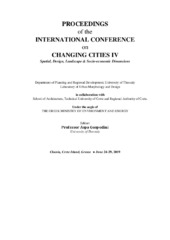Prikaz osnovnih podataka o dokumentu
Principles of Resilient Territorial Strategies - Case Study of Integrated Strategy for Tourist Valorisation of Skadar Lake
| dc.creator | Mrđenović, Tatjana | |
| dc.date.accessioned | 2024-04-03T08:57:44Z | |
| dc.date.available | 2024-04-03T08:57:44Z | |
| dc.date.issued | 2019 | |
| dc.identifier.isbn | 978-960-99226-9-2 | |
| dc.identifier.issn | 2654-0479 | |
| dc.identifier.uri | https://raf.arh.bg.ac.rs/handle/123456789/2109 | |
| dc.description.abstract | The notion “territory” is a set of all development factors of space in the broader sense (economic, social, social, political, natural, created, market, etc.) into a holistic, unique entity, managed in a sustainable manner, including all dimensions of sustainable development and stakeholders. It goes out of the administrative border and is defined by needs and the interests of all actors. SUSTAINABLE DEVELOPMENT is the concept (according to Reeve is the youngest urban paradigm) whose imperative is the integration of development sectors: economics, society, the environment (both natural and natural) in order to systematically manage renewable and nonrenewable resources. Renewable resources (natural or created - artificial) are those that can be restored within a certain period of time. Therefore, their use in accordance with sustainability must take place in the cycles of their regeneration (for example, the timber logging dynamics takes place in the timing of the planting of new seedlings and their growth).Non-renewable resources, such as cultural and historical heritage and protected natural assets, must be strictly protected. Often it happens that, by their nature, the renewable sounds of accelerated exploitation are converted into nonrenewable (for example, White bears are renewing their reproductive activity, but climatic influences, as well as human action, have made them become currently non-renewable and require strict protection. Sustainable development is in the cross-section of three development rallies, enabling in this way cultural, economic, social and ecological living and living places. This means that human activity in one sector must have positive or at least zero effects on other development sectors (UNHabitat 2005). On the other han, RESILIENCE implies the capacity of the system to abandon a redundant or replaceable element with the openness to reorganize elements (adaptability) and integrate new ones that enable it to grow / DEVELOPMENT (Mrđenović, 2013). The thesis I stand for is that resilience implies the process of managing the regeneration of the territory system for the sake of its sustainability. The aim of the paper is to prove this thesis on case study “Integrated Strategy for Tourist Valorisation of Skadar Lake” in order to outline the principles of resilience in urban and spatial planning. | sr |
| dc.language.iso | en | sr |
| dc.publisher | Volos : University of Thessaly, Department of Planning and Regional Development, Laboratory of Urban Morphology & Design | sr |
| dc.rights | openAccess | sr |
| dc.source | Proceedings of the International Conference on Changing Cities IV: Spatial, Design, Landscape & Socio-economic Dimensions Chania, Crete Island, Greece, June 24-29, 2019 | sr |
| dc.subject | resilience | sr |
| dc.subject | sustainable development strategy | sr |
| dc.subject | planning | sr |
| dc.subject | territory | sr |
| dc.subject | regeneration | sr |
| dc.title | Principles of Resilient Territorial Strategies - Case Study of Integrated Strategy for Tourist Valorisation of Skadar Lake | sr |
| dc.type | conferenceObject | sr |
| dc.rights.license | ARR | sr |
| dcterms.abstract | Мрдјеновиц, Татјана; | |
| dc.rights.holder | Tatjana Mrdjenovic | sr |
| dc.citation.spage | 1065 | |
| dc.citation.epage | 1065 | |
| dc.description.other | [https://changingcities.prd.uth.gr/cc/index.php] | sr |
| dc.identifier.fulltext | http://raf.arh.bg.ac.rs/bitstream/id/7443/bitstream_7443.pdf | |
| dc.identifier.rcub | https://hdl.handle.net/21.15107/rcub_raf_2109 | |
| dc.type.version | publishedVersion | sr |

